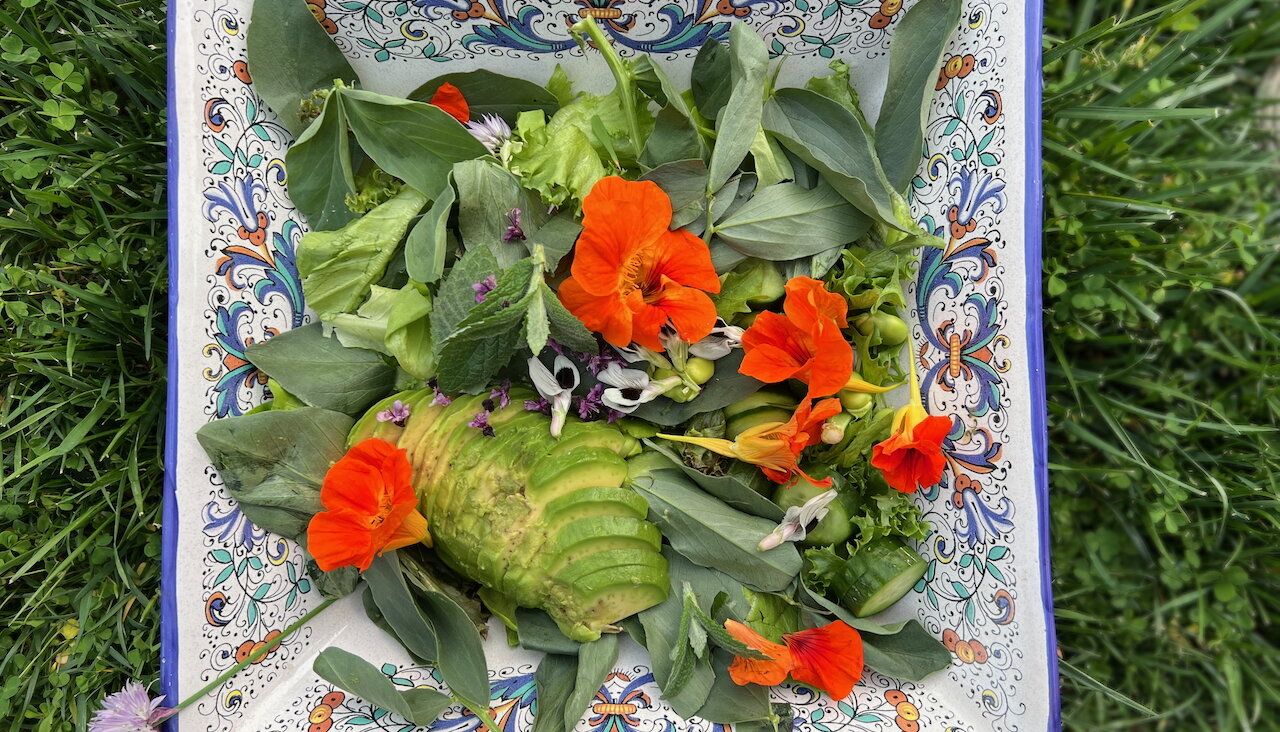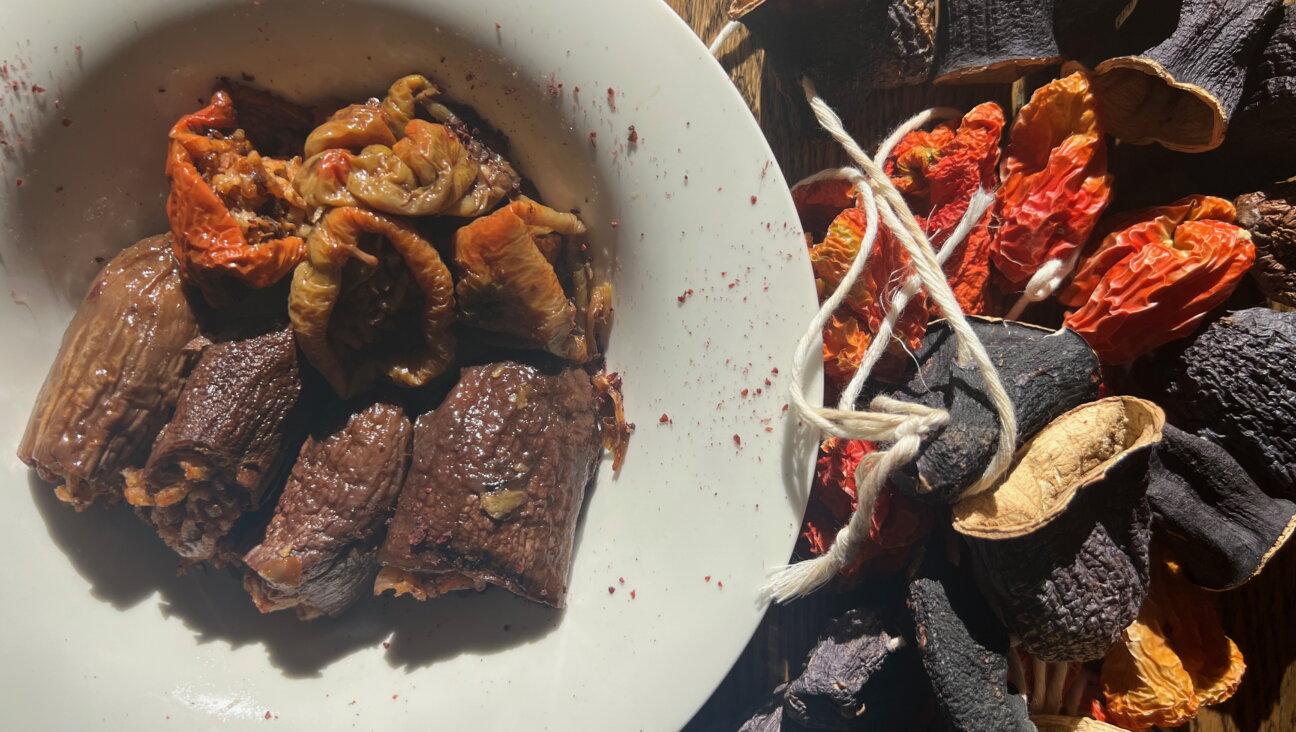A different doughnut for each Hanukkah night

Papanasi Image by Wikimedia Commons
Cantor Evan Kent is obsessed with sufganiyot.
As soon as the Israeli Hanukkah doughnuts start appearing in bakeries at the beginning of the Hebrew month of Kislev, weeks before the festival, Kent launches into his tastings. He samples the gamut, from the ubiquitous red jelly-filled to the decadent halva or dulce de leche-flavored, at gas stations or at high end patisseries.
“I never eat an entire donut” he wrote via e-mail. By the time Hanukkah actually starts, he’s done with doughnuts and has latched on to latkes.
Of course, each oily food in Kent’s annual routine is a traditional Chanuka treat among Jewish communities around the world. The oil used to fry each dish recalls the miracle of the oil lasting in the rededicated Jerusalem Temple in the second century BCE.
The modern Hebrew word, sufganiyah, initially referred to foods that soaked up oil like a sponge, including latkes and doughnuts, based on the ancient Hebrew word for a type of sponge cake, (sufgan). Eventually sufganiyah came to refer to doughnuts only. Jelly- filled doughnuts probably made aliyah with Jews from Poland (pączki) and ultimately embedded in Israel’s palate through the Histradrut labor union’s advocacy for professional bakers in the 1920’s.
Around the world, Jewish communities have commemorated Hanukkah with variously named, regionally- influenced, often yeast- risen fried doughs, usually dairy and egg- free, as well as homemade fried doughs topped with honey, rose water, or orange water syrups. Their Muslim and Christian neighbors also enjoyed them at Ramadan and Christmas. Easily prepared, they may appear again at Purim or be adapted for Passover. Why not?
These recipes for each night of the festival, with distinctive shapes and flavorings, highlight Jewish diversity through time and place.

Zalabia Image by Debbie Prinz/Evan Kent
Night 1: Zalabia
A drawing in the tomb of Ramses III from approximately 1200 BCE illustrates two cooks deep frying spiral shaped dough resulting in, according to some, today’s zalabia. These spirals, coils or free-form doughs, traditional for Hanukkah, pervade Egypt, India, Iran, Iraq, Kurdistan, and Turkey. Sometimes the syrup or the dough is dyed a bright orange, yellow, or red. Kurds serve them at Tu B’Shvat as well.

Loukoumades/Bumuelos Image by facebook
Night 2: Loukoumades/Bumuelos
Fried dough balls, popular throughout the Middle East, may have roots in ancient Greece. Some say this oldest recorded dessert was served to Greek Olympic victors in 776 BCE, covered in honey, topped with sesame seeds. Greek Jews or Romaniote (Jews in Eastern Mediterranean since at least 3rd century BCE, preceding Sephardim to Greece) call them zvingoi or zvingous, the bread eaten by the Maccabees.
Later Sephardi culinary tradition yields a similar fried dough ball, called bimuelos. After 1492 converso, or secretly Jewish, families continued to make them in December, though they had forgotten why. By 1547 the word bimuelos appears in Ladino (Judeo-Spanish) bibles (Numbers 11:8). A 17th century traveler in the Ottoman Empire, Evliya Celebi, recorded seeing Jews frying them in oil while their neighbors used butter or lard.
The Danish Christmas treat, aebleskiver, seems to be a similar treat of adaptation. Indeed, the Danish-born mother of Uri Scheft (Lechamim Bakery, Tel Aviv, and former co-owner of Breads Bakery, NYC) makes them for Hanukkah in Israel. These cardamom-flavored pancake balls with apple are served with jam. As with bumuelos, there’s even a specially designed pan to maintain the shape of the balls (though the pan is not required).

Atayef Image by Debbie Prinz
Night 3: Atayef
These double-fried, crescent-shaped, filled pancakes have roots with 9th century chefs to the Caliph of Baghdad. Jews in the Middle East have enjoyed them since at least the 10th century when Rabbi Saadia Gaon explained an unusual biblical Hebrew word as atayef. He noted that his neighboring Muslims enjoyed it at Ramadan, in his Arabic translation of the Torah (tzapihit, Exodus 16:31). Gil Marks, author of The Encyclopedia of Jewish Food notes that atayef were so popular among Egyptian Jews that Ibn al-Qata’if, meaning son of the pancake maker, became a popular name. Food writer, Claudia Roden, calls them “one of my favorite Arab sweets.”

Fritelle Image by Debbie Prinz
Night 4: Frittelle di Chanukah
Italian Jews prefer diamond-shaped, anise- and raisin-filled dough, dipped in honey. Frittelle began as a popular Venetian pre-Lent carnival doughnut and expanded into regional variations in Italy. Jews also prepare precipizi, piles of smaller dough balls.

Sfenj Image by Debbie Prinz
Night 5: Sfenj
Jews from Morocco brought sfenj to Israel. The popular, lifesaver-shaped fried dough, gathered in bunches with a rope or palm leaf, may have first appeared in the 8th century. They are eaten at breakfast and afternoon tea. Neighborhoods would often feature sfenj bakers frying their goods on a central, raised platform.

Papanasi Image by Wikimedia Commons
Night 6: Papanasi
This stunning Romanian treat cuts out the center of its cheesy dough to fry the tube and the center separately. Later, berry-topped cheese or yogurt fills the hole, and the fried middle crowns that. Romanian Jews, who introduced this to Israel and to America, also enjoy them at Shavuot.

Image by youjeencho/ Unsplash
Night 7: Proto-Sufganiyot
It is certainly possible to make fancy sufganiyot at home. However, skip back to the origins of a fried, filled dough, for two simpler approaches. One version slathers jam between two slices of bread (leftover challah?) and fries that. Or, make a doughnut dough, cut it into rounds or squares, fill two rounds with jam, and fry those.
Night 8: Churros
Doughnut making tips:
1. Use a deep pot, a Dutch oven or a wok for the frying.
2. A tall candy thermometer helps track the heat of the oil, which generally works best at 375º.
3. Use an oil with a high smoke point and neutral taste, such as refined peanut oil, canola, safflower, sunflower, grape seed, cottonseed, corn, or soybean.
4. Before serving and adding toppings, drain the doughnuts on paper towels.
5. Any recipe with liquor helps to minimize absorption of oil.
6. I like to serve the topping separately to allow guests to sweeten to taste.
For further reading:
Emily K. Alhadeff, “The Great Doughnut Schlep”
Ty Alhadeff, “Manna from Heaven: Bumuelos, A Sephardic Hanukkah Treat”
Gil Marks, Encyclopedia of Jewish Food
Rabbi Deborah R. Prinz lectures about chocolate and Judaism around the world based on her book, “On the Chocolate Trail: A Delicious Adventure Connecting Jews, Religions, History, Travel, Rituals and Recipes to the Magic of Cacao” (Jewish Lights). She co-curated the exhibit “Semi[te] Sweet: On Jews and Chocolate” for Temple Emanu-El’s Herbert and Eileen Bernard Museum, New York City.
The Forward is free to read, but it isn’t free to produce

I hope you appreciated this article. Before you go, I’d like to ask you to please support the Forward.
Now more than ever, American Jews need independent news they can trust, with reporting driven by truth, not ideology. We serve you, not any ideological agenda.
At a time when other newsrooms are closing or cutting back, the Forward has removed its paywall and invested additional resources to report on the ground from Israel and around the U.S. on the impact of the war, rising antisemitism and polarized discourse.
This is a great time to support independent Jewish journalism you rely on. Make a gift today!
— Rachel Fishman Feddersen, Publisher and CEO
Support our mission to tell the Jewish story fully and fairly.
Most Popular
- 1

Culture Cardinals are Catholic, not Jewish — so why do they all wear yarmulkes?
- 2

News School Israel trip turns ‘terrifying’ for LA students attacked by Israeli teens
- 3

Fast Forward Ye debuts ‘Heil Hitler’ music video that includes a sample of a Hitler speech
- 4

Fast Forward Student suspended for ‘F— the Jews’ video defends himself on antisemitic podcast
In Case You Missed It
-

Yiddish קאָנצערט לכּבֿוד דעם ייִדישן שרײַבער און רעדאַקטאָר באָריס סאַנדלערConcert honoring Yiddish writer and editor Boris Sandler
דער בעל־שׂימחה האָט יאָרן לאַנג געדינט ווי דער רעדאַקטאָר פֿונעם ייִדישן פֿאָרווערטס.
-

Fast Forward Trump’s new pick for surgeon general blames the Nazis for pesticides on our food
-

Fast Forward Jewish feud over Trump escalates with open letter in The New York Times
-

Fast Forward First American pope, Leo XIV, studied under a leader in Jewish-Catholic relations
-
Shop the Forward Store
100% of profits support our journalism
Republish This Story
Please read before republishing
We’re happy to make this story available to republish for free, unless it originated with JTA, Haaretz or another publication (as indicated on the article) and as long as you follow our guidelines.
You must comply with the following:
- Credit the Forward
- Retain our pixel
- Preserve our canonical link in Google search
- Add a noindex tag in Google search
See our full guidelines for more information, and this guide for detail about canonical URLs.
To republish, copy the HTML by clicking on the yellow button to the right; it includes our tracking pixel, all paragraph styles and hyperlinks, the author byline and credit to the Forward. It does not include images; to avoid copyright violations, you must add them manually, following our guidelines. Please email us at [email protected], subject line “republish,” with any questions or to let us know what stories you’re picking up.















